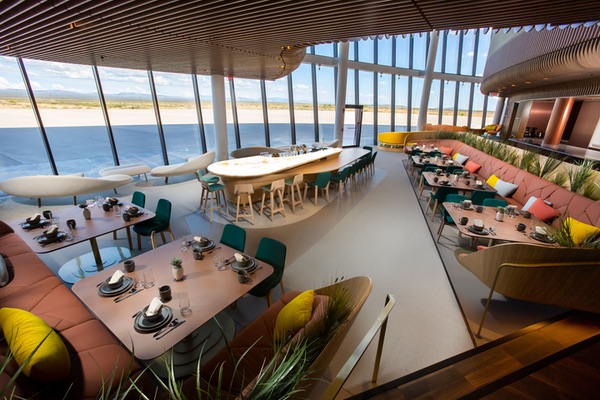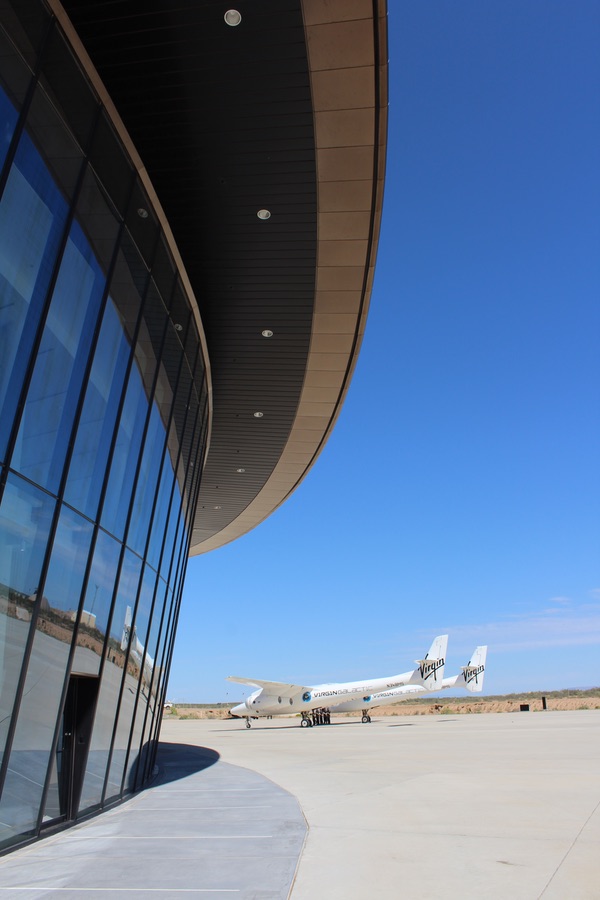
An “operationally ready” spaceportby Jeff Foust
|
| “It’s a really important day to share with you some of the progress and to declare operational readiness for Spaceport America,” said Whitesides. |
The company brought reporters out not to review its cuisine (the lunch was, for the record, quite good) but to show how the company was finally closing in on commercial operations at the spaceport, including work outfitting the interior of the main terminal building at the spaceport, the Gateway to Space.
The building itself was completed nearly eight years ago, dedicated at an October 2011 ceremony that featured Virgin Galactic’s founder, Sir Richard Branson, dangling off the roof of the building, clutching a giant bottle of champagne (see “A gateway to space emerges in the desert”, The Space Review, October 24, 2011). The interior, though, was unfinished, although the company then expected to quickly move ahead with that, as at the time it anticipated flying SpaceShipTwo on suborbital spaceflights by the end of 2012.
As recently as last October, though, the building’s interior remained primarily bare floors and walls, that outfitting work pushed back given delays in the development of the vehicle. But in the last ten months Virgin Galactic has worked to transform the interior into something ready to accommodate the company’s employees and customers.
“Every time I come here, there’s this level of anticipation,” said Jeremy Brown, Virgin Galactic’s design director, during last week’s tour. “The story of the Gateway to Space is one of transforming us mere mortals into commercial astronauts through this building.”
That tour included the lower level of the spaceport, which the company calls “Gaia” and includes the abovementioned dining area and lounge for customers and guests. As the name suggests, the layout is done in earth tones that the company said in a release last week “aims to bring the stunning landscape which surrounds spaceport inside”—so, lots of shades of brown.
That release included an entire paragraph describing “Barista Island,” which sounds like a reality TV show but is instead a coffee bar (“made of back-lit Italian marble hovering above hand-crafted oak,” the release explains) that the company describes as the “social hub” of the spaceport. That was the case on the tour, as staff and guests mingled there during breaks in the event.
 What was bare floors and walls for years after the building’s completion is now a dining area and lounge for the company’s staff and guests. (credit: Virgin Galactic) |
The real action, though, was on the second floor, dubbed “Cirrus” and done, as the name suggests, in shades of white. This level is home to the mission control center and overall flight operations for SpaceShipTwo and WhiteKnightTwo. On the tour, that level was up and running, and in fact overseeing a “mission”: a test flight of WhiteKnightTwo, which arrived at the spaceport early last week as part of the ongoing transition of flight operations from Mojave, California to New Mexico.
That WhiteKnightTwo flight was intended to help prepare pilots and controllers for upcoming SpaceShipTwo flights from the spaceport. “We were practicing one of the two different routes we’re going to use when we fly SpaceShipTwo,” explained Virgin Galactic flight director Bill Kuhlemeier, depending on whether the flights take off to the north or to the south.
That work, he said, including coordinating airspace with both White Sands Missile Range, which controls the large swath of restricted airspace the spaceport uses, as well as neighboring airspace under control of the FAA. The flights are designed to minimize any closures in FAA-controlled airspace that could affect commercial aviation.
Company staff, including pilots, said they’re very happy with their new facilities at the spaceport. Mike “Sooch” Masucci, one of the company’s pilots, was on hand for the tour and said he appreciated, among other things, the ground-to-roof windows on the side of the building looking out over the runway, with the mountains in the distance. “It keeps us motivated, but more importantly, keeps our heartbeat on what’s going on outside,” he said.
The flight of WhiteKnightTwo, and the tour of the terminal building, were intended to demonstrate that Virgin Galactic was moving ahead with plans to start commercial operations at the spaceport—after years of waiting—in the near future. “It’s a really important day to share with you some of the progress and to declare operational readiness for Spaceport America,” George Whitesides, chief executive of Virgin Galactic, said in remarks opening the tour.
| “Everything is purpose-built for what we want,” Moses said. “It was built for what we knew we needed.” |
In May, the company announced it would start moving operations over the summer from Mojave to New Mexico, giving staff the opportunity to move their families over the summer holidays rather than in the middle of the school year. Whitesides said the company was “well along” in that effort, with 89 employees now working in New Mexico and another 50 to 60 to make the move in the near future. “That’s good news for the state,” he said, “and good news for our operational readiness.”
Among those getting a look around the spaceport was Howie Morales, the state’s lieutenant governor. “I don’t know about you,” he said in comments shortly after WhiteKnightTwo took off behind him, “but I was looking up as the flight took off and got the chills, and the reason is I thought back, serving in the legislature for 11 years, seeing the transformation of what’s taking place right here.”
That transformation is not yet complete. While WhiteKnightTwo is at the spaceport, the company’s existing SpaceShipTwo vehicle, VSS Unity, is still in Mojave, having made its last flight to space nearly six months ago. Mike Moses, president of Virgin Galactic, said that work is continuing there to outfit the cabin interior for commercial flights, along with other upgrades, like the installation of a new digital flight control system.
The company didn’t say when VSS Unity will arrive here—when it’s ready WhiteKnightTwo will fly back to Mojave to pick it up—but when it does arrive Moses said the company will first perform a couple glide flights to test the new flight control system as well as get familiar with operations from a new spaceport.
After that, “we’ll be ready for rocket-powered flights,” he said. There are eight hybrid rocket motors stockpiled at the spaceport, he noted, although he didn’t commit to a specific number of test flights before commercial operations will begin. In documents filed last month in association with the company’s planned merger with holding company Social Capital Hedosophia, Virgin stated it expected commercial operations to begin in the first half of 2020 (see “A new path for space investment?”, The Space Review, July 29, 2019).
 WhiteKnightTwo prepares to pull into the hangar at the Gateway to Space after its August 15 test flight. (credit: J. Foust) |
Moses, who is among those who has made the move to New Mexico, said he was very happy with the new facility. “Everything is purpose-built for what we want,” he said. “It was built for what we knew we needed.”
| As for the yet-to-be-completed top level of the spaceport, Hunter said, “There’s some top-secret stuff happening up there that we can’t unveil until our customers see it for the first time.” |
That operational readiness that Whitesides declared, Moses said, goes beyond simply being able to support flights. “We’ve been able to bring the vehicles down here in the past. What we’ve not really had is the home for the staff: the lounge and office spaces, the mission control facilities, are now all up and running,” he said.
That includes things like Barista Island, which sounds superficial but, as he noted, has the ability to bring together staff from different parts of the complex together. “It’s not like rocket science, but it’s nice to see that functional design actually influencing people’s daily lives at work.”
The spaceport’s own transformation is not yet complete. Besides Gaia and Cirrus, there is a third level still being completed that will be used by Virgin Galactic’s customers to prepare for their flights. That area was not included in the media tour. “This is a construction zone right now,” said Julia Hunter, senior vice president of Virgin Galactic. “There’s some top-secret stuff happening up there that we can’t unveil until our customers see it for the first time.”
After many years of delays, those customers may soon be able to finally get a glimpse of that level and the rest of the spaceport, and see what it will really be like to fly to the edge of space. And maybe grab a cappuccino at Barista Island while they wait for their turn to fly.
Note: we are temporarily moderating all comments subcommitted to deal with a surge in spam.